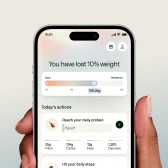What is emotional eating and why do people do it
Emotional eating is a type of coping mechanism that people use to deal with emotions. Whilst the triggering emotions are most often negative like stress, boredom or sadness, people also eat for happy emotions too—like celebrating an occasion or using food as a reward.
It’s important to remember that it’s perfectly normal to eat for emotional reasons. In fact, there is a biological mechanism behind it—stress, boredom and anxiety all cause an increase in cortisol levels in your body and this drives our cravings for high-carbohydrate and high-fat foods.
There are also psychological/sociological drivers, like if your parents gave you a sweet treat when you fell over as a kid to make a sore knee better, your brain would have created a connection between sweet food and feeling better.
It’s very common for people to use food to mask uncomfortable feelings, and although it can provide momentary relief, it doesn’t address the underlying problem and it can exacerbate feelings of guilt and shame.
The benefits of managing emotional eating
By managing emotional eating, it can help us to become more attuned to our body’s natural hunger signals and avoid weight gain from excess calories. Additionally, it can help us to develop a healthier relationship with food, reduce stress and improve mood. When we’re not using food as a coping mechanism, we’re more likely to make nutritious choices that promote our overall health and well-being.
How to recognise emotional eating:
Do you know the difference between physical hunger and emotional hunger?
Well, there are 8 traits of emotional hunger (Virtue, 1999) to look out for:
- It comes on suddenly
- It is for specific foods, no substitutes will do
- It begins in the mouth (your mouth wants to taste that specific food) and mind (it whirls with thoughts about the desired food)
- It is urgent—you need to eat that food immediately
- It is paired with an emotional need rather than a physical need
- It involves automatic or absent-minded eating
- It does not stop in response to physical fullness
- It is often accompanied by guilt
- It’s a good idea to get into the habit of questioning your hunger—“Is this physical hunger or emotional hunger?”
How to manage your emotions without turning to food
Once you’ve identified emotional hunger, the next step is to identify what you are actually hungry for emotionally. Once you’ve identified the emotion driving the craving, you can try more effective approaches to manage that emotion. For example, if you’re feeling stressed, then doing something physical like going for a run to use up all that cortisol will help. If you’re feeling lonely, reach out to a friend. If you’re feeling anxious, try a 3-minute breathing or meditation exercise.
Take Action ⚡:
Next time you notice a craving, try these steps to address it:
Step 1: Question your hunger: is this physical hunger or emotional hunger?
Step 2: Identify what emotion is triggering the craving
Step 3: Find an alternative to food to satisfy your emotional hunger
Overcoming emotional eating can be very challenging but the benefits to your physical and emotional health are worth the effort. Keep practising the techniques in this article and you’ll be well on your way to healing your relationship with food.
While we’ve ensured that everything you read on the Health Centre is medically reviewed and approved, information presented here is not intended to be a substitute for professional medical advice, diagnosis, or treatment. It should never be relied upon for specific medical advice. If you have any questions or concerns, please talk to your doctor.













